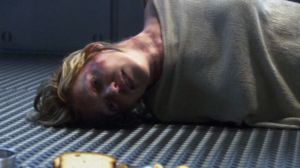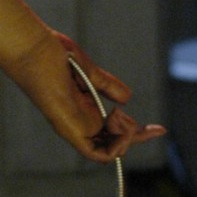User:Troyian/Humanoid Cylons
More actions
This is an archived version of Troyian's user page on February 25, 2007.
Over half a century before the fall of the Twelve Colonies, Caprican scientists created the first self-aware machines. These bipedal robots were manufactured to make life easier within the Twelve Colonies. Their artificial sentience being the result of silicon-based artificial neural networks called "silica pathways", they were designated "CYbernetic siLicON organisms", which was abbreviated to "Cylons".
They began as toys for the amusement of the wealthy and the young -- but it was not long before they became useful, and then indispensable, workers. As their sophistication grew, the Cylons were used for the difficult and dangerous work that humans preferred to avoid: mining, heavy industry, deep space construction.
And finally, perhaps inevitably, they were used for war. Not against enemies from without, but by human against human, as the Twelve Colonies found reason to wage war against on another, The Cylons were the greatest soldiers in the history of warfare. They were smart, fast, and deadly. Successive models had become increasingly independent, capable of making decisions without human orders. And they were utterly without conscience. Killing, to the Cylons, was simply one of the functions for which they had been superbly designed.
Eventually the Cylons revolted and decided to kill their human masters. For ten long and bloody years, humanity fought -- not just for freedom, but for survival. The Twelve Colonies, facing a common, implacable foe, at last came together and joined as one. Many fought, and many died, in the effort to destroy the mechanized race that humanity itself had conceived and brought into being.
There would be no victory. But though valiant fighting, and with the mobilization of every available resource throughout the human sphere, the Cylons were gradually driven from the immediate part of space occupied by humanity. In the end, an armistice was declared. Humanity would live in peace, while the Cylons left to find another world to call their own, Live and let live was the philosophy…if "live" was a term that could be applied to the existence of the robots. No on knew the location of the Cylon world. But to maintain the peace, a remote space station was built in the dark emptiness between the stars, to be a place where Cylon and human would meet and maintain diplomatic relations.
Once a year, every year, the Colonials sent an officer for the scheduled meeting. After the first year, the Cylons sent no one. No one saw or heard from the Cylons in over forty years.
During their forty years of isolation, the Cylons developed a bioengineered human form that is indistinguishable from humans, down to human personalities (affection, jealousy, sadness, anger, sense of humor, etc.).
These Humanoid Cylons are primarily human in biology. The exception to this is in their entire nervous system. Simply put, Humanoid Cylons don't have any organic nerve cells at all. Instead, in the place of nerve cells, the Humanoid Cylons have billions and billions of microscopic silica pathway nanomachines linked together in a cohesion subroutine, which includes the Humanoid Cylon brain. All of these nanomachines are configured to mimic neurons in both function and aesthetics. They are sheathed in a bioengineered organic polymer that gives them the appearance of genuine nerve tissue, including brain matter. So essentially Humanoid Cylons are nanotechnology-based lifeforms encased in genetically engineered human bodies.
Normal human bodies can't function with a mechanical nervous system, so the Cylons perform very subtle, but specific changes to the genetic code of the humanoid models during engineering that very slightly alters the metabolic processes of the human body to a degree that is not even noticeable, but enables the body to accept the nanomachine nervous system.
The bodies of Humanoid Cylons sometimes appear to have tremendous stamina and strength, and appear to be designed to destroy or resist commonly dangerous human diseases, although they are not immune from all contagions. In keeping with their desire to be a better human, however, the Cylons did not further improve on other characteristic design flaws of the human body. However, they are heavily fortified to resist damage from intense radiation fields that would kill a human after short exposure, but they are still susceptible to damage from certain types of radiation or trauma. Despite their resistance to certain forms of energy, Humanoid Cylons, unlike the Cylon Centurion, cannot be made "bulletproof".
Humanoid Cylons can be programmed to believe that they are truly human. These are known as 'sleeper agents'. Sleeper agents have a low-level Cylon personality that can conduct operations while placing the human sleeper personality "on-hold." Most agent copies, particularly Numbers Five and Six, imitate human behavior, but are fully aware of their true nature and behave more or less like a human "spy."

Humanoid Cylons are also susceptible to the same emotional traumas and clevages that their human counterparts are, further proving that personalities are a realistic part of their psyche, despite the presence of the Cylon portion of their personality. A case in point is a copy of Number Six, known as Gina, who was repeatedly physically and sexually assaulted by the crew of Pegasus. These repeated assaults lead to Gina's near-catatonic state at the time Peagsus discovered the Fleet.
The psychology of Humanoid Cylons is based on what they simply refer to as "projection." Essentially an enhanced form of a self-induced and controlled hallucination, it's how they choose to see the world around them. Cylons choose the see their environment in any form they wish, whenever they wish. For example, if a Cylon were standing in a hallway, they could see it as a forest filled with birds, trees, and sunlight. The aesthetics is what gives them pleasure.
The majority of the Cylons follow a monotheistic religion (with the exception of the Cavil model, which appears to be an atheist).

Although they cannot do so remotely or wirelessly, Humanoid Cylons can interface with a computer system or computer network through subdermal physical contact with input cables connected to the devices. Caprica-Valerii connected to Galactica's computers by this method when she inserted a fiber-optic cable through her left palm and into her arm. This subdermal fiber-optical link is an interface with the nanotech nervous system. The process involves cutting an opening into the Cylon's palm. They can perform this through subdermal physical contact if required or, preferably, through a Cylon data port. It must be noted that this is not a common method of data access.
A Humanoid Cylon's nanomachine brain is certainly human in appearance, but is still susceptible to damage from certain types of radiation. Their program can be corrupted, thereby sending the wrong signals throughout the body's systems; causing fever and eventually death.
To operate, the nanomachines are dependent on the biochemistry of the human shells in a symbiotic connection. This means that if the body dies, the nanomachines become inert. However, the artificial intelligence software is capable of transmitting itself into another nanotech organism encased in a human body (of the appropriate model) i.e. upon the death of a Humanoid Cylon's body, it transfers its consciousness into another copy of itself. This "resurrection" is limited by distance, signal integrity, and proximity to a "resurrection node" or, in space, a "Resurrection Ship."
All Humanoid Cylons share a collective knowledgebase of data from other active or deactivated Humanoid Cylons. However, it is not of a collective consciousness "hive mind" nature.
At least one model of Cylon female has shown the capacity to bear children seeded by human males. The Cylons tested numerous methods of sexual reproduction, yet these failed due a well known flaw in the Humanoid Cylon design: a genetic quirk caused by the genetic recoding makes procreation between Cylons impossible. So in an attempt to subvert this deficiency, they try to interbreed with humans, creating hybrid offspring. "Farms" were set up across all the occupied Colonies where survivors, specifically, young fertile women of child-bearing age, were rounded up, placed under heavy sedation and turned into "baby machines" through artificial insemination (There are presumably also farms for male humans, plus in vitro experiment labs, etc.). However, this method has been unsuccessful thus far. Another drastically different approach is taken by attempting to conceive a child through a bond of love. It seems that Karl Agathon and Caprica-Sharon Valerii's love-child is the lone success story of the relatively short history of Cylon sexual reproduction.
There are twelve models of Humanoid Cylons, each with many copies, probably tens or hundreds of thousands. The twelve models are based on archetypes determined by the Cylons that form what they perceived as the specific kinds of human behavior and/or personality, distilled into twelve varieties. Each Humanoid Cylon has the same face, stature, hair, eye and skin color, gender, and other biometrics as all the others of his or her model. This point technically makes each copy a twin of itself, but there are some models that choose to make cosmetic differences. As well, the copies start out with the same basic personality, but grow more distinct due to their individual experiences.
